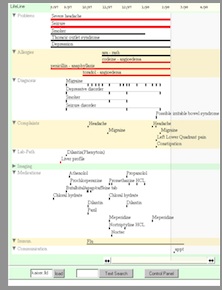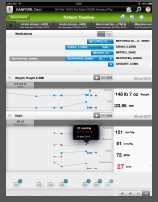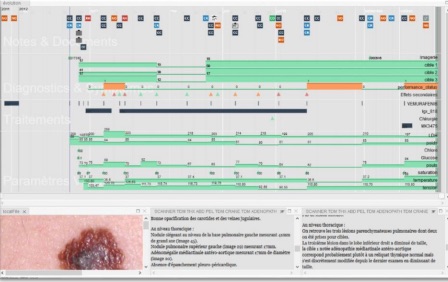Participants
Publications
Prototypes
Sponsors

| Jump to:
Participants Publications Prototypes Sponsors |
 |
The Lifelines project started in 1994 with research grant from the Maryland Department of Juvenile Services . We developed a new technique called Life-Lines to visualize personal history records. In 1995 we started working with IBM Watson Research Center and Kaiser Permanente Colorado to extend the technique to medical records. At the time IBM's Kaiser system was one of very rare computerized system combining data from diverse sources (e.g. notes, pharmacy data, test results, etc.).
LifeLines provided a novel general visualization environment for personal histories. A one screen overview of the record using timelines provides direct access to the data. For a patient record, medical problems, hospitalization and medications can be represented as horizontal lines, while icons represent discrete events such as physician consultations, progress notes or tests. Line color and thickness can illustrate relationships or significance. Semantic zooming and filters allow users to focus on part of the information, revealing more details.
LifeLines are easy to understand with no or limited training and can facilitate the spotting of anomalies and trends, streamline the access to details (as LifeLines act as large menus) and reduce the chances of missing information.
We believe that LifeLines have applicability to a number of the health care projects. Computerized medical records pose tremendous problems to system developers. Infrastructure and privacy issues need to be resolved before physicians can even start using the records. Non-intrusive hardware is required for physicians to do their work (e.g. interview patients) away from their desk. But all the efforts to solve these problems will only succeed if appropriate attention is also given to the user interface design. Long lists to scroll, clumsy searches, endless menus and lengthy dialogs will lead to user frustration. Techniques are being developed to summarize, filter and present large amounts of information, leading us to believe that rapid access to needed data is possible with careful design.
1:2:
3:
4:

5:6:
7:
8:

1) Harvard I2B2 (screenshot ~1997)
2) PatientLikeMe, e.g. Fig.2 from Frost and Massagli, 2008
3) Southampton EPR, from " Rew, D.A. Indian J Surg Oncol (2011)
4) Wand Timeline view of a patient record in Allscripts ambulatory EHR iPad application Used with permission of Allscripts. (screenshot 11/2012)
5) HealthTronics UroChartEHR (Screenshot accessed 07/2014)
6) iSALUS EHR (Screenshot accessed 02/2015) See also the nice Vitals screen)
7) UHR Rennes PEP platform. Screens from 2017 presentation.
8) VIP from Baudel and Brochard paper at Visu 2018 (IBM Fance Lab)
Catherine Plaisant, Assistant Research Scientist
Ben Shneiderman, Professor Computer Science
Anne Rose, Faculty Research Assistant
Jia Li, Graduate Student Computer Science
Diane Lindwarm (Alonzo), Graduate Student Psychology
Dan Heller, Undergraduate Student
Partha Ghosh, Graduate Student ISR
Richard Mushlin, IBM Watson Research Center
Aaron Snyder, Kaiser Permanente Colorado
and we thank John Karat (IBM) for his leadership and support
Other HCIL projects on visualization of temporal data, e.g. Eventflow for exploring temporal patterns
The original Juvenile Justice project where LifeLines was "born".
Related HCIL workshops:
(1997) Visualizing Personal Histories: a Workshop (July 21-22, 1997)See also: HealthInfoDesign Resources on design and medical informatics.
(2004) Personal Medical Devices Workshop: Increasing Patient Healthcare Participation (June 3, 2004)
(2008) Interactive Visual Exploration of Electronic Health Records (May 30, 2008);
and many more, e.g.
(2014) Workshop on Exploring Temporal Patterns in Electronic Health Record Data (Thursday, May 29, 2014)